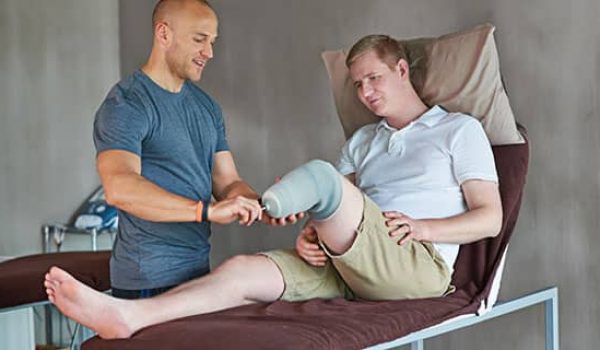When a person has an amputation due to various reasons such as accident, infection, cancer, tumor, etc., it is natural that the living conditions for him will be different than before, and because the human foot is the backbone of his body. And the human body is based on the feet, so that the amputee can walk on two legs as before and do his daily activities, and more importantly, to regain his spirit, it is often recommended. Use an artificial leg instead of an amputated limb. But did you know that it is possible to use a prosthetic leg implant if the stump (remaining member) in the amputee is able to do so. Therefore, after amputation surgery, the necessary measures should be taken to prepare and stump care.
One of the best ways is to implant a prosthetic leg implant. Hamyar Teb Lian medical team, as the only artificial leg implant center in the Middle East, in collaboration with Dr. Aziz Abbaspour, has implanted artificial leg implants for amputees in order to keep their life expectancy alive and the possibility of living under normal conditions. He created them again.
Stamp preparation and stump care steps (remaining member)
After the amputation, after the stitches have been removed and the surgical wound has healed, the stump (remaining limb) can now be prepared for the prosthetic implant. The amputee during this time, who is preparing the stamp, should keep these goals in mind:
• Put the remaining limbs in the right position
• Stretch and strengthen muscles
• Touch and reduce organ sensitivity
• Remaining limb formation
• Daily body care and hygiene
Put the stamp in the right position
Keeping the remaining limbs in the proper position and taking care of the stump is crucial. This helps prevent muscle shortening and tightening (contracture). To prevent muscle contraction, it is necessary to keep the knees and pelvis somewhat straight. Some suitable positions are listed below.
Do not hang the stump when sitting.
Sleep on your stomach for hours a day, this will stretch the muscles in the front of the pelvis. Repeat this for 15 to 20 minutes each time.
Never place a blanket or pillow under the remaining limb, and do not place the stump above the knee.
Stretch and strengthen muscles
You need to keep the muscles in your remaining limbs strong and do the exercises that you are taught in the hospital for this purpose. This helps prevent muscle contraction and also ensures that the stump member is strong and flexible, in fact the stump must be strong to move with the prosthesis.
Touch and reduce organ sensitivity
After surgery, the skin left on the limb will initially be sensitive to touch. Things that can help reduce this sensitivity and speed up the process of caring for the stump are: massage, rubbing and tapping the remaining limb. To begin, gently touch the limb first and increase the pressure as the stump becomes less sensitive. This movement helps prepare the limb for accepting the prosthesis at the amputation site.
Shaping the stamp (remaining member)
After surgery, although the wound heals, the remaining limb may still be swollen. This swelling is not good at all and should be reduced so that the remaining limb can be attached to the appropriate prosthesis. For this purpose, the health care team recommends the use of a special compression sock to shape the remaining limbs. A compression sock is a conical sock that puts pressure on the ends of the remaining limbs, which reduces the swelling of the limb. These socks should be used 24 hours a day.
Stump care and follow the hygiene tips
Maintaining the remaining limbs and taking care of the stamp is crucial to prevent skin problems and infections. That’s why the following steps should be taken every day:
• Wash the remaining limbs at least once a day. Use warm water and mild antibacterial soap to do this.
• Dry the stamp thoroughly. This removes moisture between your skin and the compression stocking.
Use clean socks every day. Wash each sock with soap and lukewarm water, rinse well and dry thoroughly to remove salts and acids from your sweat.
Note that the remaining organs must be examined daily and the doctor should be informed if any of the following symptoms are seen:
• Separation of the skin from the surgical wound
• The presence of an unpleasant odor on the scar or wound on the limb remains
• If the area around the wound becomes hot or red or swollen
• Yellow, brown or gray discharge from the wound
• Sudden increase in severe pain or tenderness
• Fever above 38 degrees Celsius







